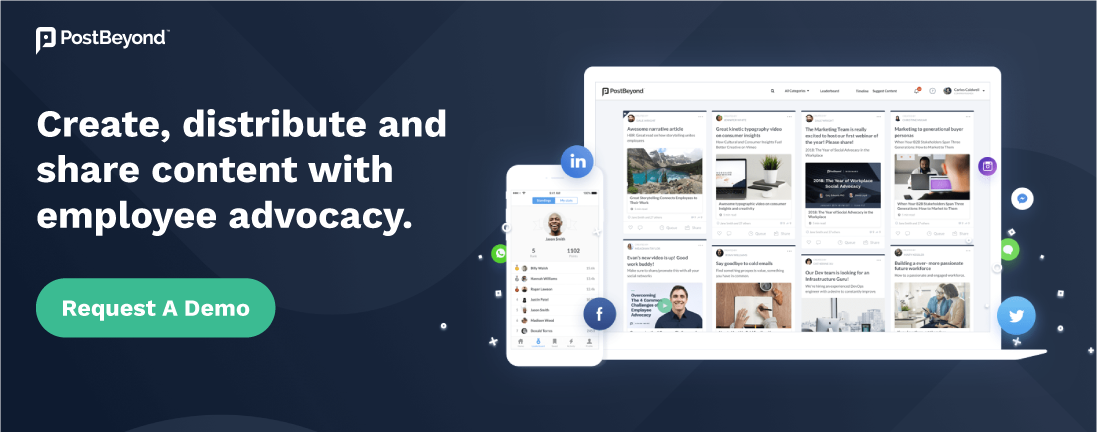Employee advocacy programs have been around for a while and many forward-thinking organizations are already achieving impressive results (increased organic reach, greater share of voice and influx of social leads). While most marketers see the value of an employee advocacy program, selling the idea to your organization and getting buy-in from executives can still be a challenge, especially for more traditional organizations.
Why Employee Advocacy?
Why employee advocacy? Why now? With all the recent changes (fake ads, data misuse, GDPR, etc.) employee advocacy can provide a way to improve organic reach, create compliant marketing touchpoints, and drive lead generation without the worry of potentially ballooning ad spend.
Interest in employee advocacy has grown 191% since 2013 because it leverages the reach and trust of your employees to deliver brand messages to your target audiences. And there are numerous stats to back up employee advocacy program success:
- Company branded messages reach 561% further when shared by employees versus branded channels.
- 70% of adults online reported trusting recommendations from friends and family, but only 15% trusted companies’ social media posts.
- According to IBM, when a lead is generated through social selling or employee advocacy that lead is 7X more likely to close compared to other lead gen tactics.
Looking for more stats to help secure employee advocacy buy-in? Click Here.
Steps to Gain Employee Advocacy Program Support
While stats and case studies certainly help to sell a program, successful employee advocacy programs hinge on initial planning and deployment. To secure buy-in for an employee advocacy initiative, it is imperative to present executives with a well thought out deployment strategy.
SMART Goals
SMART (aka specific, measurable, attainable, realistic, and timely) goals for the program must be created in order to influence program priorities and needs. Is the goal of your program to create a greater share of voice, increased website traffic, more social engagement or maybe all three? Whatever the goals are, they need to be clearly defined with methods to both track and report on progress.
Deployment Plan
As the saying goes, ‘ideas are easy. It’s the execution of ideas that really separates the sheep from the goats.’ PostBeyond has been apart of hundreds of successful employee advocacy programs and they all contain the same fundamental steps:
- Social Media Policy Revamp: before launching an employee advocacy program, updating and recirculating a social media policy will help to mitigate risk by providing employees and executives with more guidance and best practices when sharing on social.
- Training & WIIFM: Social media skills will vary throughout your organization. Different age groups and departments will have different needs. Mapping out a strategy to both train and generate employee support is critical. In addition to sessions teaching employees how to use social media for business, communicating the What’s In It For Me (WIIFM) factor will help secure higher adoption rates. Employees need to understand how employee advocacy will not only help the business but also their personal-professional goals.
- Pilot Programs: Studies show, roughly 30% of your employees are already acting as brand advocates. Leverage these enthusiastic individuals to create a pilot program. This pilot will help to further refine social media policies and training programs ensuring a smoother, more successful, full-scale rollout.
Measuring ROI
Employee advocacy programs involving one thousand active participants can generate the equivalent of $1.9M in advertising value. With employee advocacy program goals and a deployment roadmap in place, the final piece to securing program support is presenting how ROI will be measured. It is important to think strategically about how you will track and measure your program goals. Here is a comprehensive guide to tracking employee advocacy attribution with PostBeyond.
To help showcase the potential success that can be achieved through employee advocacy, leverage some of PostBeyond’s examples and case studies:
- How I Closed a $20K Deal from One Social Share
- How Drift Amplifies Product Launches & Drives Leads With Employee Advocacy
Leadership Support
Launching an employee advocacy program without full leadership support is dooming a program to fail. In addition to communicating the program goals, deployment roadmap and metrics, taking the time to showcase how leadership support positively affects employee advocacy is an essential step to securing not only the initial buy-in but also ongoing support.
Getting support for new marketing initiatives can be a challenge, but achievable if done strategically. Presenting a well thought out program with specific goals, deployment roadmap, and defined metrics will help generate greater support.





